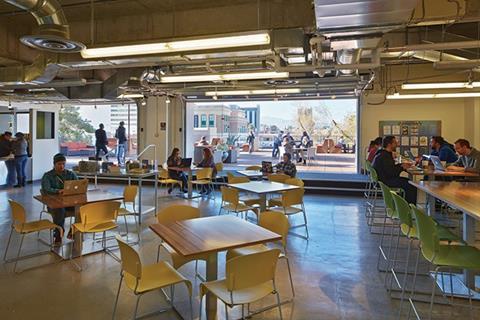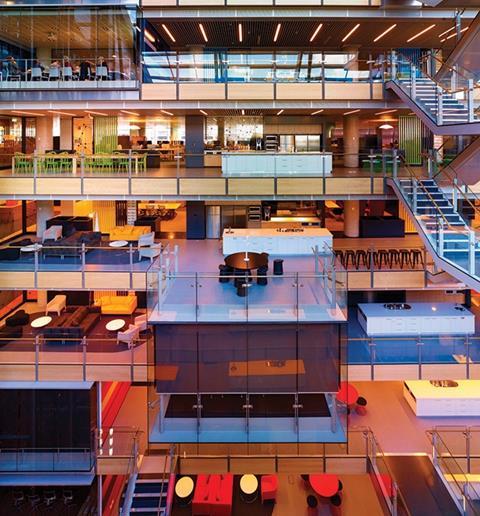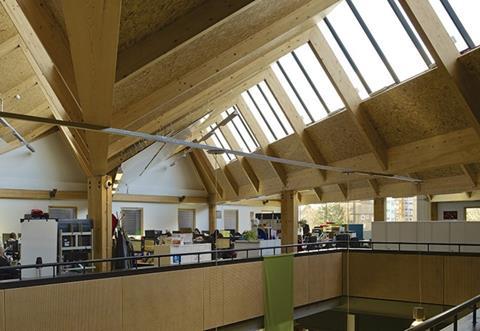There is a strong body of evidence of the tangible ways that building design can improve wellbeing. Now an increasing number of major clients are realising that this is not just good for employeesā health - itās good for business

To the uninitiated, āhealth, wellbeing and productivityā might sound like an alternate title for the āmind, body, spiritā section of Waterstones. Donāt be fooled: itās an emphatically evidence-based discipline, with a watertight business case that makes low-energy construction look practically New Age in comparison.
Thereās nothing new about the idea that buildings can affect occupantsā health - sick building syndrome has been discussed since the eighties, and there are already regulations to ensure reasonable indoor air quality on aspects such as ventilation and toxic chemicals. But over the last couple of decades, a growing body of evidence has shown that the design of building can have a far more subtle impact on the overall wellbeing of those who use it. Studies have found that hospital patients with views of nature healed more quickly, that office workers with a window seat sleep an average of 46 minutes longer per night and that doubling the supply of outdoor air to an office reduces short-term sick leave by 35%.
Not everybody cares about carbon and energy, but whoās against health and wellbeing? Who doesnāt want to be seen to be pushing that agenda?
Richard Francis, The Monomoy Company
Last year, the World Green ŠŌ°ÉµēĢØ Council brought all of this together in a landmark publication, āHealth, Wellbeing & Productivity in Offices, the next chapter for green buildingā. It presented evidence on a range of factors including air quality, lighting and thermal comfort, but also layout, the look and feel of a space, and contact with nature. It then proposed a framework that organisations could use to analyse how their own premises were affecting their staff. It was an instant hit, backed by JLL, Lend Lease and Skanska, and enthusiastically embraced by industry clients including British Land, Tishman Speyer, Stanhope, Grosvenor, Sky TV and Marks and Spencer.
Perhaps thatās not surprising given that wellbeing is a much more attractive message than the abstinence typically preached by the green movement. And in contrast to climate change, itās something that individual organisations can actually do something about. āWhen youāre talking about health and wellbeing, itās almost immediately positive because you donāt have to spend that much to get better results,ā says Richard Francis, principal of The Monomoy Company. āAlso, not everybody cares about carbon and energy, but whoās against health and wellbeing? Who doesnāt want to be seen to be pushing that agenda?ā
Good for business
So far, thereās been a lot of talk about sustainabilityās ātriple bottom lineā but action has been overwhelmingly focused on the environment. Health, wellbeing and productivity shifts the balance towards the social and - compellingly - the economic too. Wellbeing is about much more than physical health, stresses Francis. āThatās part of it, but itās not sufficient. Wellbeing is a step beyond - itās feeling mentally engaged, inspired, having a sense that your employer is looking out for you.ā
Apart from the sense of wellbeing that an employer gets from doing the right thing, thereās also a very strong business case for it. A frequently cited statistic is that energy bills account for about 1% of a businessā operating costs, while costs associated with staff make up 90%. Itās easy to see the impact that even a slight drop in absentee rates or employee turnover could have on profits.
If building occupiers have much to gain, owners and investors have even more to lose. Tenants can argue for lower rent if a building consumes a lot of energy - what if it could be shown to reduce employee performance? āFive years ago, most people didnāt know about the energy performance of buildings but now it affects their value. With wellbeing, the numbers are so much more significant to an organisation. This used to be at the bottom of the list for due diligence, but itās increasingly making its way up.ā
Wellbeing is likely to be market driven, believes John Alker, co-author of the report and director of policy and communications at the UK Green ŠŌ°ÉµēĢØ Council. But without more detailed research, thereās a danger that it could be reduced to a mere marketing tagline. āThese are complex issues, so we need to be careful not to boil it down too much - you can have wellbeing but not be particularly productive, and you can be productive for short periods of time without being healthy. Without robust evidence, we wonāt have the ability to prove whether a building is genuinely good for peopleās wellbeing and what is good performance in relation to other buildings.ā This is the next step for the UK Green ŠŌ°ÉµēĢØ Council, expected to be the subject of an announcement at Ecobuild.
In fact, companies have everything they need to at least begin analysing the impact of their building on performance: the buildingās complaints log, HR data on sickness or absence, and financial data on the performance of teams in different offices. āThis is information which every organisation already has, or could easily get,ā says Francis.

Robust evidence
Getting a true picture of wellbeing means using more qualitative data too, typically from staff surveys. āYou can tap into attitudes which arenāt necessarily going to show up at all, or only show up down the line when they get much worse. People say things like āI find the office uninspiringā. We might ask āare you proud to bring visitors to the office?ā or ādo you think the office reflects the corporate values?ā - youāre never going to find the answers by looking at air quality.ā
Elina Grigoriou is design director of Grigoriou Interiors and founder of the not-for-profit Feeling Good Foundation, set up to promote research on wellbeing in the built environment. She is researching a book that aims to provide a reasoned basis for design decisions on wellbeing: āThere is no ābestā interior, it depends on the user. The ultimate target is to create a harmony between the occupant and the space.ā So is it a science or an art? āThere is an explanation behind using a particular colour or a piece of furniture, and people are beginning to realise that interior design is not just about having a bit of fun with colour.ā
As the industry amasses data and case studies, Grigoriou believes it will become possible to be more exact about how design contributes to wellbeing. āWe canāt yet say that using five curved shapes and two angular ones gives you this level of productivity, but I like to think weāll be there in five years.ā
People are beginning to realise that interior design is not just about having a bit of fun with colour
Elina Grigoriou, Grigoriou Interiors
The real past masters at this kind of analysis are of course retailers, and theyāve also spotted the opportunity. Leading the pack is M&S, under its Plan A sustainability strategy. Last June, it committed to carry out a study into the āhealth, wellbeing and associated commercial benefits of sustainable retail buildingsā and apply the lessons by 2016. The impetus came from a post-occupancy evaluation of its Cheshire Oaks eco-store, which revealed that it was not only outperforming its environmental targets but that customer and staff satisfaction, and sales, had risen.
āWe realised that we were probably underestimating the total business case for sustainable building, and that we should take health, wellbeing and productivity into account,ā says Zoe Young, Property Plan A project manager at M&S. āIf we can prove the hypothesis, we can go to the decision-makers and say not only is a building going to be X% more efficient and cost less to run, but itās going to be X% more profitable because of the design. We want to use that to influence the retrofit of existing shops and the design of new shops across the world.ā
Retailers already compile masses of data that could feed into this, she adds, from footfall surveys and CCTV to loyalty card schemes and customer feedback. M&S hopes to collaborate with other organisations on the research, and will reveal more about the plans at Ecobuild.
A wake-up call
There is not necessarily a perfect correlation between a lower energy building and one that improves wellbeing. There are some easy wins: more daylight means less artificial light, and comfortable occupants donāt tend to override carefully chosen setpoints or light settings. A building people enjoy being in is also less likely to be knocked down before the end of its design life. But there could also be perverse outcomes: if the business case for the comfort of employees is so powerful, whatās to stop employers racking up massive energy bills to create the perfect, most profitable, working environment? āWe canāt have a conversation about this in isolation from sustainability,ā says Alker. āThe challenge is how you meet both objectives at the same time.ā He points out that the WELL ŠŌ°ÉµēĢØ standard, developed in the US, is designed to be compatible with existing sustainability rating tools.
Wellbeing potentially goes much further than current standards. On walking into a WELL-certified building, the first thing youād notice would probably be the lighting - not just more daylight, but better quality artificial lighting that changes throughout the day to match humansā circadian rhythms, says Ann Marie Aguilar, associate director of Arup Associates, who is a provisional WELL accredited professional. āThe air quality would feel different, there would be much greater availability of fresh water and really good quality food. There would be much more focus on the individual and a more ergonomic environment.ā
Her colleague Mallory Taub adds: āPrinciples that might have been standard practice for hospitals, on ventilation and water filtration, are becoming business as usual. Product suppliers already have to notify users about the amount of recycled content, and there will be a further dive into the chemical components of products. Itās a wake-up call on a whole other level.ā
But if productivity provides an economic rationale for all this, it canāt be the only driver, she says: āWe donāt want it to be about just trying to get more productive people in the big machine. Itās got to be broader than that, giving people a sense of general wellbeing, the opportunity to be the best they can be.ā

Conference highlights
Happiness by design: How the built environment drives feeling and behaviour
Tuesday 3 March
13.30 - 14.30
Paul Dolan, professor of behavioural science, London School of Economics and Political Science
Occupier wellbeing: How do we measure it and what does it mean for the property industry?
Wednesday 4 March
12.00 - 13.00
- Host: Jane Henley, chief executive officer, World Green ŠŌ°ÉµēĢØ Council
- Richard Francis, principal, The Monomoy Company
- David Richards, director, Arup
- Michelle Moore, senior vice president, international, WELL ŠŌ°ÉµēĢØ Institute
- Elina Grigoriou, design director, Grigoriou Interiors
Biophilic design: How incorporating nature creates value and improves wellbeing in buildings
Wednesday 4 March
16.30 - 17.30
Oliver Heath, founder, Heath Design
People before profit: Designing cities with wellbeing at heart
Thursday 5 March
12.00 - 13.00
- Lord Richard Best, president, Local Government Association; and chair, All Party Parliamentary Group on Housing and Care for Older People
- Ken Livingstone, former Mayor of London
- Tim Gill, owner, Rethinking Childhood
- Phil Jones, managing director, Phil Jones Associates; and panel member, CIHT Urban Design Panel
- Chris Brown, chief executive, Igloo Regeneration























1 Readers' comment